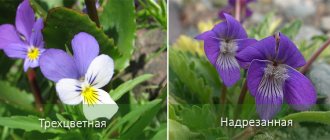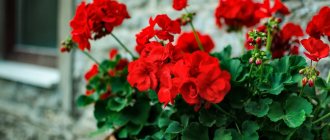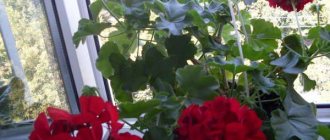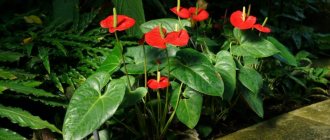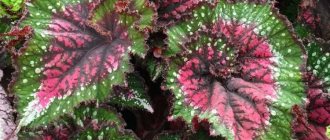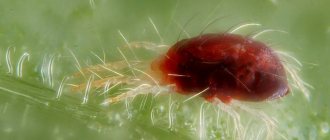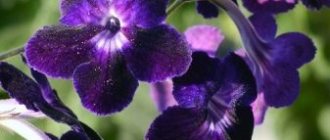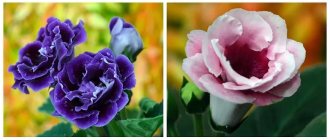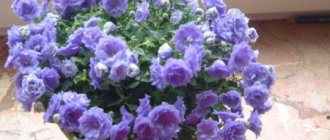What kind of flower is this?
Gloxinia brocada are subshrubs belonging to the Gesneriaceae family . This plant has a tuberous rhizome.
Gloxinias vary in rosette size, for example, there are microminiature, the radius of the rosette usually does not exceed 5 mm, miniature, where the radius of the rosette reaches 20 mm, semi-miniature, where the radius varies from 20 to 30 mm, and standard, where the radius exceeds the size of 30 mm.
Gloxinia brocada is a miniature plant. The birthplace of the flower is South America. And to be more precise - Brazil. It was in this country that the plant was discovered in 1785, and botanists called it speckled gloxinia. Surprisingly, the flower also has the name Sinningia .
Reference! Gloxinia owes its origin to two botanists – doctor Gloksin and Sinning. It was in their honor that this creation of nature was named. And now, thanks to the efforts of breeders, work has been going on for 200 years, due to which more and more new varieties of these wonderful flowers are being born. The result is also clean, rich petal colors.
Home care
Care consists of choosing suitable soil, sufficient light and maintaining soil and air moisture levels.
Gloxinia requires regular watering during the growing season. Watering should be done with warm, settled water, slightly warmer than room temperature. You can water at the root, but it’s better in a tray. And then drain the water after 15–20 minutes. When the flowers fade, watering should be stopped, but during dormancy, it is enough to water the plants once a month or even less often. The main thing is to prevent the tubers from drying out.
Fertilizing is necessary throughout the entire growing season from April to August; it is applied once every 7–10 days. Use specialized complex fertilizers for indoor flowering plants containing potassium and phosphorus. You can alternate organic and mineral fertilizers.
You can trim the stem where the flowers and leaves were after flowering. Only the lowest few leaves are left. Then they fertilize with nitrogen, then they will begin to grow again and new buds will appear. The most active flowering period is June-July. But it happens that flowers appear one after another, then pruning is not necessary.
When the plant begins to dry out in the fall, do not trim the leaves while they are still green. Pruning will be required if the gloxinia does not fall off for too long.
In February, the tubers are taken out for planting. Sometimes the plant wakes up earlier and then produces white sprouts. Replanting is done every year into a larger pot. Moreover, it is better to choose a wide rather than deep container, since the roots will grow wider to a greater extent. Gloxinia loves light and airy soil. Leaf soil, peat, and turf are suitable for such conditions. You can make a mixture of equal parts of these soils, as well as part of sand, or buy ready-made soil. Be sure to place pebbles or other small stones at the bottom of the pot for good drainage. It is better to steam the soil to destroy harmful microorganisms.
Video: Gloxinia transplant
It is better to keep the tubers in potassium permanganate before planting. Plant the plant in the ground with 1/3 of the tuber. When the shoots begin to grow, you need to leave 3-4 of the strongest ones, the rest are removed. After removal, the next day the tuber is covered with soil so that the level above the root is about 1 cm. After this, watering is carried out, and the pot is placed in its permanent place.
Caring for gloxinia during the dormant period
When the plant has finished flowering, it should be placed in a dry, cool and well-ventilated place with a temperature of up to +13°C. The dormant period usually begins in October-November. Watering should be stopped gradually. Starting in August, reduce the amount of watering.
The above-ground part begins to fade. The leaves dry out and fall off. There is no need to remove them until they dry out. After the green parts die off, everything is cut off so that a stump of about 1.5 cm remains above the tuber.
- Remove them from the pot and clean them from the soil. Can be treated with fungicidal preparations. Place in a container with dry sand, sawdust, perlite or peat and leave in a cool place, possibly in the refrigerator.
- Perhaps just fill the pot with tubers on top with sand. Likewise, leave in a cool, dark place.
- You can just leave it in the ground. Storage conditions are the same. Only in this case you need to water it sometimes (approximately once a month), but do not flood it. Or spray the surface, then this can be done more often.
The rest period lasts from 1 to 3 months. If the tubers are not stored in proper conditions, the plants will wake up too early and the sprouts will be weak.
Gloxinias, which only grow for the first year, are not sent to rest. They are left in the light and watered. The older the plant, the more it should be in a state of rest. Tubers are usually removed from the dormant period in February.
Varieties
Blue
Gloxinia blue has double flowers, the diameter of which reaches 8 cm, usually blue or purple with a thin and neat white border. The bush itself reaches a height of 20 cm, where from 10 to 25 large double inflorescences grow.
Red
Gloxinia red is a profusely flowering and beautiful plant with small flowers, the diameter of which reaches 6 cm. The color is bright red, the border predominates or is absent. The bush size is usually 20 cm.
Do you want to know what are the main differences between Tydea and Gloxinia? Also see materials on growing other types of synningia: Krasnoyarsk, climbing, hybrid, Rosalind, Sonata, White Terry, Kaiser Wilhelm and Friedrich, as well as pink.
Seed method
But if you want to become like a breeder and develop your own unique hybrids, you can start breeding flowers from seeds. The generative method of reproduction is a rather long and labor-intensive process, but it has its advantages:
- The florist will be able to become the owner of a rare variety, since flower shops offer a wide selection of seed material.
- With this method of breeding, it is possible to feel like a breeder, having received your own hybrid
How to get gloxinia seeds at home
Original gloxinia seeds can only be obtained through artificial pollination and subsequent collection. The whole procedure looks schematically as follows:
- During flowering, pollen from the stigma of the female flower is transferred to the pistil of the male flower.
- After a few days, the corolla wilts, in place of which a seed pod is formed.
- Seed collection, depending on the variety, is carried out 1.5-2 months after signs of capsule opening appear.
You will see the details in the video:
Advice! Since gloxinia seeds are very small, it is worth transferring the cut box to a white container, where it is easier to see the brown seed.
Timing for sowing gloxinia seeds
Before planting gloxinia seeds, you should know: the germination rate of the seed depends on time.
When sowing in autumn or winter, the duration can be 9-10 days, while sowing in the spring-summer period will reduce the interval to 4-6 days.
Step-by-step recipe for growing gloxinia from seeds
Gloxinia from seeds at home is grown as follows:
- A shallow container for seedlings is prepared, which is filled with a layer of light substrate with a loose structure of peat and sand in equal parts.
- The seeds are distributed over the surface of the soil, after which they are moistened with a spray bottle.
- The container with the crops is covered with glass and placed in a well-lit place with a temperature within 22-23°C.
- When the shoots appear, the glass is removed.
- After the formation of 2 pairs of true leaves, the seedlings are planted in separate disposable cups, from where, after a while, the seedlings are planted in individual pots.
Attention! Peat tablets demonstrate good results when growing gloxinia from seeds.
External description of the plant
Gloxinia is a rather interesting flower. Its undoubted advantage is the presence of various leaf shapes, but in particular these are large leaves of juicy green or dark green color.
Gloxinia brokada is a terry variety. It is divided into several types, which depend on the color of the petals: calico, plain and tiger. Single-color buds have only one shade, calico buds are characterized by dots of different sizes, and brindle buds are characterized, in addition to specks, by rims on the edge of the petals.
Gloxinia brocade flowers are a single color. Magnificent flowers with bright buds rise above the dark green leaves, forming a ball shape, making the bush seem lush. That's why they are called double - they have several rows of petals, which is why the bush seems rich in flowers. And indeed it is.
Appearance features: description and photo
Below you can find a description and photo of Gloxinia Krasnoyarya and Little Red Riding Hood:
cap
Little Red Riding Hood. Huge, finely sprayed red two-row tigers, with a slight ruffle along the edge of the petals. Along the edge of each petal there is a spectacular crimson-scarlet edging. The neck is snow-white with speckles of a dark crimson tone. The rosette is neat, compact, the flowering stems are short. The foliage is moderately green. The variety was bred by breeder Olga Artyomova.
Krasnoyarsk
The rosette is neat, the flowering stems are strong. The flowers are very large, double type, bright, and look impressive. The color is like a fiery ruby, presented both in single-color fragments and in a thick spray on the surface of the petals. The edge of the petals is highlighted. The buds open one by one, and the flowering gradually gains volume and abundance. Gloxinia is a pure red color, without cherry and raspberry impurities.
Peculiarities
The peculiarities of Gloxinia brocade begin with the flower itself, because the plant has a fairly small compact rosette, and thanks to this the buds look quite large. The color of the plants is usually uniform, but sometimes there is a border of a lighter shade than the petals.
The petals are like velvet both in appearance and to the touch. Gloxinia brocade flowers are one of the most persistent flowers that last a long time on the peduncle itself. The undoubted advantage of this plant is its abundant flowering. In one cycle, the plant can bloom up to 25 buds .
The most spectacular varieties of terry gloxinia
There are some types of flowers that are used in a special way.
This:
Winter cherry is the most elegant variety of white gloxinia; its light petals are covered with specks of red and burgundy. This gloxinia loves good care: you need to keep it in a bright and warm room
Please note that you should not overdo it with watering. Gloxinia “Winter Cherry” blooms in the second half of spring - early summer
The buds on gloxinia are arranged together, magnificently, which looks very impressive. The Kaiser Wilhelm variety is unpretentious, it grows quite quickly and adapts perfectly to any indoor conditions, which attracts novice gardeners. The leaves of the bush are fleshy, so the plant looks good, and it begins to bloom quite late: in the second half of summer. The purple color of the petals of this gloxinia variety smoothly turns into a bright white border. The petals, velvety to the touch, look delicate among the abundant foliage. The May Queen has large white flowers with a wide pink border around the edges and a dark throat at the back. The bush is small, when the weather is hot, the flower stalks emit a pleasant aroma, although this does not happen every time it blooms, but only sometimes. Cleopatra. This synningia was bred artificially; the petals of this original variety have strong waviness, and it blooms long and profusely. The color of the buds is most often soft pink or white; sometimes you can find buds with small dark dots along the edges, which connect in the middle and form purple stripes. This variety blooms for an extremely long time: from April until the very beginning of September. Due to such a long flowering period, high-quality and regular fertilizing should be included in home care, so the buds will be more luxuriant. However, you also cannot overdo it with fertilizers, otherwise only leaves will develop. The Yesenia variety is distinguished by its considerable height - it can grow up to thirty centimeters, which is unusual for this species, but only if it is taken care of properly (it does not like excessive watering and dry air). This variety is very lush, and snow-white flowers appear quite early - at the very beginning of March. Brocade. Gloxinia of this variety is always double red, but it may have a slightly bluish tint. Her flowers, however, are monochromatic, but large and extremely bright. This variety blooms magnificently and a lot; if the care is correct, up to 25 flowers can bloom on one plant.
Before you start growing terry gloxinias, you should keep in mind that these varieties have their own specific rules: the buds do not develop so quickly and do not bloom all at once, but one by one, gradually, although this does not apply to some varieties.
In any case, Sinningia with large double flowers has been the hit of the season for many years. Lush rosettes collected in a bouquet always look gorgeous, no matter what color the buds are.
How and where to plant?
To grow this beauty, you need bright and diffused light, the main thing is that its rays do not fall directly on the future plant. Gloxinia has fairly small seeds. For sowing them, loose soil is used, the composition of which is turf soil, humus, sand and leaf soil in a ratio of 1: 1: 1: 2.
Before sowing, the soil is disinfected. After which it needs to be watered. Planting is usually carried out from the end of February to March. Seeds are carefully placed in a greenhouse container at a distance of 3-5 cm. The crops are covered with film or glass in order to maintain moisture. The soil must contain nutrients, allow air to pass to the roots of the future flower and not retain water. The container is placed in a warm place. Seeds should not be planted at temperatures below 24 degrees. The soil is usually moistened, this needs to be monitored.
After the first true leaves have formed, the gloxinia should be planted in separate pots. An overgrown tuber of a plant must stick out a little from the ground. When watering the future flower, you do not need to touch the leaves.
Advice! It needs to be grown until 3 true leaves are formed. This means that gloxinia should be picked. Usually the leaves grow after 4 months from sowing. At the same moment, the flower tuber also grows.
The best watering option is from below. Water must be poured not into the flower pot itself, but into a saucer placed under the pot in advance.
You also need to water in moderation so that the soil does not become waterlogged. The most necessary things for successful flowering are lighting, warmth and humidity. After 6-7 months, when the tuber has already formed and the required number of leaves has been formed, Gloxinia Brocade blooms, although not so profusely.
Only 2-3 flowers are formed on a bush, but this is already a huge achievement. An already sufficiently formed adult plant produces about 25 buds.
Flower transplant
During dormancy, small shoots form on gloxinia tubers. It is during this period that the crop should be replanted. The process itself goes like this:
- First you need to prepare the tuber. Dry old roots are removed from it.
- It is then washed in water and inspected for damage or rot.
- If there are problem areas, they are cut out and the tuber is dried for 24 hours.
- Before planting, it is dipped in a solution of the drug “Maxim” or potassium manganese for 15 minutes.
- A pot is selected with a diameter of 5-6 cm. When choosing it, you should remember that the development of the root system of a crop is directed in width, so there is no need to purchase a deep container. A drainage layer of crushed polystyrene foam or expanded clay is first laid on the bottom.
- Then soil is poured with the addition of peat. A depression is made in the mixture, where the tuber is placed at 2/3 of its size.
- After which the plant is sprinkled with soil and watered. But water should only flow into the soil, and not onto the tuber and its sprouts.
Care
The most important feature of gloxinia is that it does not require special care. But still, the rules for successful flowering exist for it, and they must be followed so that the bush is lush, beautiful and pleasing to the eye. The optimal temperature should not exceed 25 degrees.
When the temperature drops, the leaves of the plant droop down and the flower “falls asleep.” As the temperature rises, the leaves tend to rise.
Air humidity should not be high, but gloxinia does not like drafts. When dry, unsightly brown spots form on the leaves. But you should not spray the plants, as this may cause rot. Fertilizers are used both ready-made and directly made independently. The supply of fertilizer is usually stopped in August.
The flower should be fed once a week or 10 days during active growth , a month after Gloxinia Brocade was planted or transplanted into new soil.
Caring for gloxinia from seeds
For full development, gloxinia from seeds requires certain maintenance conditions and care measures.
Lighting and location
For a representative of tropical flora, it is worth choosing places with unconstrained space and an abundance of bright, soft light. During long nights, it is necessary to organize an artificial light source that will ensure daylight hours of up to 12 hours.
Carefully! Due to the flower’s intolerance to drafts, the pot cannot be placed on window sills near windows that are often opened for ventilation.
Temperature
In spring and summer, gloxinia feels good at room temperatures. However, during the period of stagnation, it is recommended to provide the plant with a temperature regime of 10°C.
Air humidity
Being a representative of the tropics, gloxinia needs a high level of humidity, which can be maintained by installing a stationary humidifier in the keeping room or by placing containers of water next to the pot.
Spraying, which can harm the decorative appearance of a velvety flower, should not be carried out.
Watering rules
During the active growing season, watering is carried out both from the bottom through a tray, and from the top - preventing water from getting on the leaves and flowers of gloxinia.
When watering, which is carried out after the top layer of the soil mixture has dried, settled water is used 2-3° above room temperature. From the end of summer, the interval between watering increases , which helps prepare gloxinia for the dormant period.
Top dressing
During the period of intensive growing season, the flower is fed three times a month using complex mineral fertilizers for flowering plants, which include nitrogen.
At the end of summer, nitrogen-containing fertilizers are excluded from the fertilizing composition , since this macroelement stimulates the growth of green mass and inhibits the beginning of preparation for the dormant period.
It is also recommended to feed gloxinia once a year using the foliar method (i.e., spraying leaves and stems), using microfertilizers that include boron.
Diseases
Gloxinia, unfortunately, like all plants, is susceptible to diseases. Ascochyta blight is the most common fungal disease that occurs when humidity increases. Red, brown or brown scary spots form on the leaves.
Damaged leaves are removed, after which the plant is treated with copper sulfate and this procedure is repeated a week later.
Late blight is the most dangerous fungal disease for gloxinia . It is terrible because it affects all parts of the plant.
A moldy coating begins to appear on the leaves, they dry out when dry and begin to rot when the humidity rises.
Brown stripes form on poor stems. Another common fungal disease is septoria. Gray or gray-red spots appear on the leaves of gloxinia, the stems and shoots dry out and bend. Saving the flower in this case is quite difficult. Many people make the mistake of starting to manually tear off and pull out damaged shoots. This can lead to the rapid death of the plant.
Important! The disease occurs due to the fact that air humidity is high, the plants are placed too densely, the gloxinia soil is quite dense and the soil mixture has not been disinfected.
Gloxinia brocade is also susceptible to diseases such as gray rot, powdery mildew, which is also a fungal disease, downy mildew, and thrips.
Diseases and pests
Brocade can be susceptible to pests and diseases. The most common disease is ascochytaosis. It is caused by a fungus that occurs when there is excessive moisture. Late blight and septoria are also common. With these fungal diseases, the leaves of the plant become stained, dry out and rot. For treatment, it is necessary to remove the damaged areas and treat the bush with fungicides.
Note! Gloxinia can also be attacked by thrips, aphids and spider mites. To get rid of them, the plant must be regularly treated with insecticides.
Using the basic rules for growing and caring for Gloxinia Brocada, you can get an excellent ornamental plant that will delight you with bright flowers.

